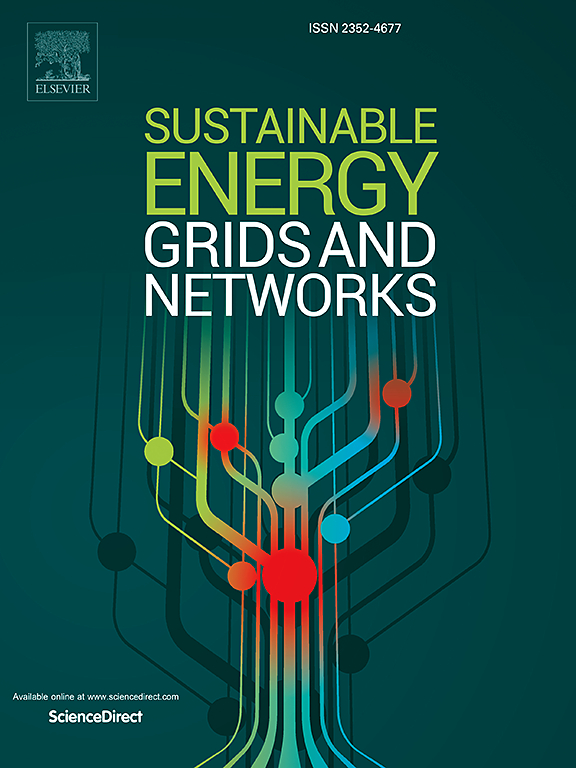两种电池交换站模式下配电网光伏装机容量评估
IF 5.6
2区 工程技术
Q2 ENERGY & FUELS
引用次数: 0
摘要
本文评估了与电动汽车电池交换站相结合的配电网的光伏承载能力。解决了两种电池交换模式:集中式和分散式。在集中式充电模式下,从各个地点收集交换的电池,并将其运送到集中充电站进行充电。然而,在分散模式下,电池在电池交换站(bss)进行交换和充电。为了探索这些模式,考虑初始充电状态、电池容量和不同的充电方案,建立了各种场景模型来模拟电池的充电。在不同场景下逐步增加光伏渗透率,并通过分析馈线电流、能量损耗、节点电压、变压器负载等技术指标,计算光伏承载能力。采用蒙特卡罗模拟方法,生成并分析一年中不同季节负荷模式、光伏发电和充电站功率相关的场景。该框架在IEEE 34总线网络上使用MATLAB和MATPOWER进行了负载流分析。结果表明,在分散模式下,HC强烈依赖于BSS的位置;当光伏机组与bss位于同一母线时,与基本情况相比,HC增加了132 %以上。此外,将电动汽车的数量从50辆增加到150辆,可使HC降低90%以上。另一方面,在集中式模式下,增加电池收集周期的频率可使主机容量提高39% %以上。本文章由计算机程序翻译,如有差异,请以英文原文为准。
Photovoltaic hosting capacity evaluation of distribution grid integrated with two modes of battery swap stations
This paper evaluates the photovoltaic (PV) hosting capacity (HC) of a distribution grid integrated with electric vehicle (EV) battery swap stations. Two modes of battery swapping are addressed: centralized and decentralized. In the centralized mode, swapped batteries are collected from various locations and transported to the centralized charging stations (CCSs) for recharging. In decentralized mode, however, batteries are both swapped and recharged at battery swapping stations (BSSs). To explore these modes, various scenarios are modeled to simulate the charging of batteries, considering initial charge states, battery capacities, and different charging schemes. The percentage of PV penetration is incrementally increased in different scenarios, and technical indicators—including feeder current, energy losses, node voltage, and transformer loading—are analyzed to calculate the PV hosting capacity. Monte Carlo simulation method is employed to generate and analyze scenarios associated with load patterns, PV power generation, and charging station power in different seasons of the year. The proposed framework is implemented on the IEEE 34-bus network using MATLAB and MATPOWER for load flow analysis. The results suggest that in decentralized mode, HC strongly depends on BSS location; when PV units are located at the same bus as BSSs, the HC increases by over 132 % compared to the base case. Moreover, increasing the number of EVs from 50 to 150 reduces the HC by more than 9 %. On the other hand, in centralized mode, increasing the frequency of battery collection cycles improves the hosting capacity by more than 39 %.
求助全文
通过发布文献求助,成功后即可免费获取论文全文。
去求助
来源期刊

Sustainable Energy Grids & Networks
Energy-Energy Engineering and Power Technology
CiteScore
7.90
自引率
13.00%
发文量
206
审稿时长
49 days
期刊介绍:
Sustainable Energy, Grids and Networks (SEGAN)is an international peer-reviewed publication for theoretical and applied research dealing with energy, information grids and power networks, including smart grids from super to micro grid scales. SEGAN welcomes papers describing fundamental advances in mathematical, statistical or computational methods with application to power and energy systems, as well as papers on applications, computation and modeling in the areas of electrical and energy systems with coupled information and communication technologies.
 求助内容:
求助内容: 应助结果提醒方式:
应助结果提醒方式:


